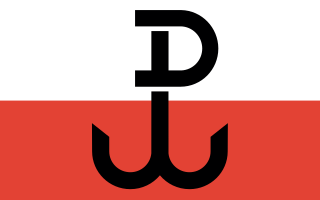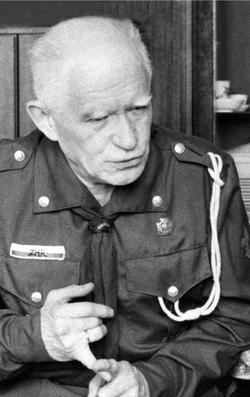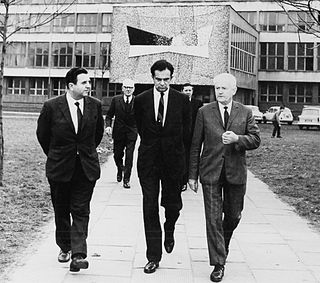
The Home Army was the dominant resistance movement in German-occupied Poland during World War II. The Home Army was formed in February 1942 from the earlier Związek Walki Zbrojnej established in the aftermath of the German and Soviet invasions in September 1939. Over the next two years, the Home Army absorbed most of the other Polish partisans and underground forces. Its allegiance was to the Polish government-in-exile in London, and it constituted the armed wing of what came to be known as the Polish Underground State. Estimates of the Home Army's 1944 strength range between 200,000 and 600,000. The latter number made the Home Army not only Poland's largest underground resistance movement but, along with Soviet and Yugoslav partisans, one of Europe's largest World War II underground movements.

The Silent Unseen were elite special-operations paratroopers of the Polish Army in exile, created in Great Britain during World War II to operate in occupied Poland.

Łapanka was the Polish name for a World War II practice in German-occupied Poland, whereby the German SS, Wehrmacht and Gestapo rounded up civilians on the streets of Polish cities. The civilians arrested were in most cases chosen at random from among passers-by or inhabitants of city quarters surrounded by German forces prior to the action.

Jan Roman Bytnar, nom de guerre "Rudy" (Ginger) was a Polish scoutmaster, a member of Polish scouting anti-Nazi resistance, and a lieutenant in the Home Army during the Second World War.

Tadeusz Leon Józef Zawadzki, alias "Kajman", "Kotwicki", "Lech Pomarańczowy", "Tadeusz", or "Zośka", was a Polish scout instructor, scoutmaster, Home Army second lieutenant, commander of assault groups in Warsaw, one of the protagonists of Aleksander Kamiński's book Kamienie na szaniec.

In Poland, the resistance movement during World War II was led by the Home Army. The Polish resistance is notable among others for disrupting German supply lines to the Eastern Front, and providing intelligence reports to the British intelligence agencies. It was a part of the Polish Underground State.

Tomasz Strzembosz was a Polish historian and writer who specialized in the World War II history of Poland. He was a professor at the Polish Academy of Sciences Institute of Political Studies, in Warsaw; and, from 1991, at the John Paul II Catholic University of Lublin. Strzembosz was a resident of Warsaw, Poland.

Szmalcownik ; in English, also sometimes spelled shmaltsovnik) is a pejorative Polish slang expression that originated during the Holocaust in Poland in World War II and refers to a person who blackmailed Jews who were in hiding, or who blackmailed Poles who aided Jews, during the German occupation. By stripping Jews of their financial resources, blackmailers added substantially to the danger that Jews and their rescuers faced and increased their chances of being caught and killed.
Operation Wieniec was a large-scale World War II anti-Nazi Home Army operation. It took place on the night of 7 to 8 October 1942, targeting rail infrastructure near Warsaw. Similar operations, aimed at disrupting German transport and communications in occupied Poland, occurred in subsequent months and years, targeting railroads, bridges and supply depots, primarily near transport hubs such as Warsaw and Lublin.
Operation Bürkl, or the special combat action Bürkl, was an operation by the Polish resistance conducted on 7 September 1943. It was the second action of Operation Heads, a series of assassinations of notorious SS officers in Warsaw carried out by the Kedyw's special group Agat ("Anti-Gestapo") between 1943 and 1944, and their first success.

Operation Kutschera was the code name for the Polish resistance's lawful execution of Austrian Nazi Franz Kutschera, SS and Reich's Police Chief in German-occupied Warsaw, outside his office on his way to work.
Operation Heads was the code name for a series of assassinations of Nazi officials by the World War II Polish Resistance. Those targeted for assassination had been sentenced to death by Polish Underground Special Courts for crimes against Polish citizens during the World War II German occupation of Poland. The operation's code name, literally "Operation Little Heads", was a sardonic reference to the Totenkopf insignia on Nazi German SS uniforms and headgear.

Operation Góral was an action carried out by the Polish anti-Nazi resistance organization Home Army, which involved a heist of over a million US dollars' worth of currency being transported by Nazi German authorities on 12 August 1943. It was carried out in the center of Warsaw by a unit of Kedyw, "Motor", which seized a transport car carrying the money. It was one of the best organized actions of the Polish underground during the German occupation, and it took only two minutes.

Jan Józef Więckowski nom de guerre Drogosław was a Sub-Scout Master in the Polish Scouting Movement, a 2nd Lieutenant of the Home Army and a Captain of the Polish Armed Forces, Polish resistance member during the Warsaw Uprising, both Chief and Chief of Security for the Second Company Rudy of Battalion Zośka, and a 1951 graduate of international economics from Stetson University.

Action Ghetto was the code name for the armed actions of the Polish Underground State during the Warsaw Ghetto Uprising aimed at helping the insurgents. The name was given to a series of combat actions carried out by the Home Army during the uprising between 19 April 1943 and May 16, 1943.
Akcja Fruhwirth - assassination attempt carried out on October 25, 1943 at SS-Scharführer Engelberth Frühwirth, which was part of an extensive campaign to eliminate representatives of the Nazi German terror apparatus in occupied Poland called Operation Heads.

Józef Pszenny - Polish military commander, sapper captain of Polish Army, head of the Sapper Department of "XII-s" Warsaw District of Home Army.

The battle of Graużyszki took place on the 6th of May 1944 near the Villages of Graużyszki, Adamowszczyzna and Sieńkowszyzna. Polish forces from the 8th and 13th Oszmiana Brigade of the Home Army under the command of Adam Walczak engaged units of the Lithuanian Territorial Defense Force under the command of Antanas Andriunas. The battle ended with a Polish victory.
The Organization of Special Combat Actions(Osa–Kosa 30) was a unit of the Polish Home Army tasked with special operations, active from May 1942 to July 1943.
Jan "Alan" Kryst, was a Polish scout and a member of Polish anti-Nazi resistance. He gained notoriety for his lone assassination attempt on Gestapo officers in the Warsaw restaurant Adria, in which he lost his life.

















